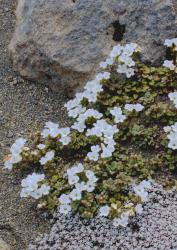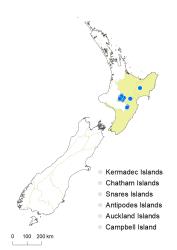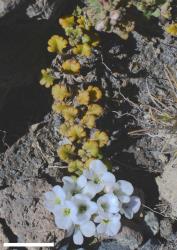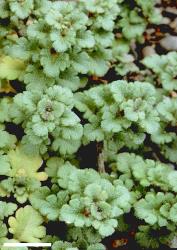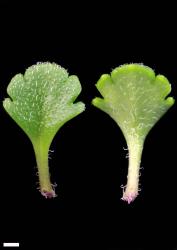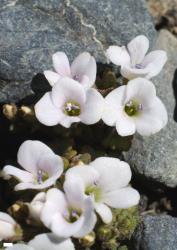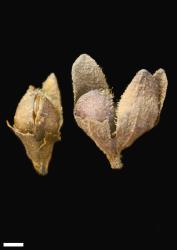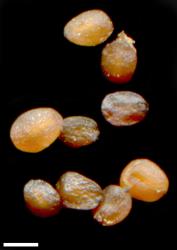- ≡ Parahebe spathulata (Benth.) W.R.B.Oliv., Rec. Domin. Mus. 1: 230 (1944)
- = Veronica vulcanica Colenso, Trans. & Proc. New Zealand Inst. 20: 203 (1888)
- = Veronica subrosulata Colenso, Trans. & Proc. New Zealand Inst. 31: 278 (1899)
Low or mat-forming sub-shrub to 0.1 m tall. Stems prostrate to ascending, sometimes erect, eglandular-pubescent; hairs uniform. Leaf bud indistinct; leaves separating while small, opposite-decussate, erecto-patent to recurved; lamina sub-coriaceous, orbicular to deltoid or rhomboid, 2–12 mm long, 1.5–12.0 mm wide, dull green to dark green above, paler beneath; midrib evident, at least beneath; surfaces eglandular-hairy above and beneath, rarely glabrous; margin glabrous or ciliate to pubescent, crenate or bluntly serrate; lobes in 1–4 pairs; apex rounded or truncate to obtuse or sub-acute; base steeply cuneate to truncate; petiole 1–11 mm long. Inflorescence a lateral raceme, 7–45 mm long; flowers crowded, 2–8, all bisexual; bracts opposite, spathulate, > pedicels; pedicels sub-erect, 1–4 mm long, eglandular-hairy all around. Calyx lobes 4, sub-acute or acute, rarely weakly toothed, equal, 2.5–3.5 mm long, eglandular-hairy or ciliate. Corolla 5–8 mm diameter; tube white to greenish, 3–4 mm long, ≤ calyx, glabrous; lobes 4, white or rarely pale purplish, spreading to recurved, unequal, elliptic to orbicular, 3.5–4.0 mm long, rounded; nectar guides absent. Stamen filaments white, 2–3 mm long; anthers pink or purplish. Style glabrous, 1.5–2.0 mm long. Capsules angustiseptate, emarginate to didymous, eglandular-hairy, 3–4 mm long, 3.0–4.5 mm at widest point. Seeds discoid or ellipsoid, flattened, smooth, brown, 1.0–1.7 mm long.
V. spathulata is distinctive among the alpine Veronica in the North Island because the corollas lack nectar guides, have flat rather than plicate lateral corolla lobes, and the capsules are hairy. The few flowers and short inflorescences also distinguish it from other species in the North Island mountains (i.e., V. lanceolata, V. hookeriana). DNA sequence data place V. spathulata in the speedwell hebe group (along with V. lanceolata and V. hookeriana), although in overall appearance plants seem similar to snow hebes.
V. spathulata plants seem similar to V. cheesemanii of Nelson, Marlborough and Canterbury, but V. cheesemanii plants are more compact and mat- or cushion-forming, with longer corolla tubes and shorter lobes; their capsules are embedded in the cushions.
V. spathulata plants often grow together with V. hookeriana and mixed collections are common. Leaves of both are usually hairy, but those of V. hookeriana are a brighter green. V. hookeriana inflorescences are long-pedunculate with smaller and alternate bracts. In V. hookeriana the lateral corolla lobes are folded, and they have prominent nectar guides.
North Island: Volcanic Plateau, Gisborne (Maungapōhatu), southern North Island (Ruahine Range).
Screes, scoria, ridges in light, stony soil, fell-field. Recorded elevations range from 1433 to 1830 m.
Flowers: December–March; fruits: January–April (old fruits persisting all year).
2n = 84 (Hair 1970, as Parahebe spathulata).
Veronica spathulata is classified in V. subg. Pseudoveronica sect. Hebe and informally in the “speedwell hebe” group (Albach & Meudt 2010). Ashwin (in Allan 1961) placed V. spathulata closest to V. cheesemanii, and they do have strong morphological similarities. Plants of both are cushion- or mat-forming with long-petiolate leaves, a tendency to turn black when dry, and strongly flattened hygrochastic capsules. Also, plants of V. spathulata sometimes have toothed or crenate bracts and calyx lobes, which are similar to the pinnatifid bracts and calyx lobes characteristic of V. cheesemanii. However, despite very different flowers and habit, molecular phylogenetic analyses (Wagstaff et al. 2002) place V. spathulata in a clade characterised by short corolla tubes, folded lateral corolla lobes, and coloured nectar guides (e.g., V. hookeriana). V. spathulata is tetraploid, implying a complex origin that might be a cause of this uncertainty.



